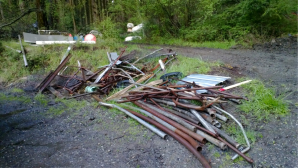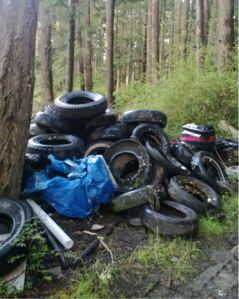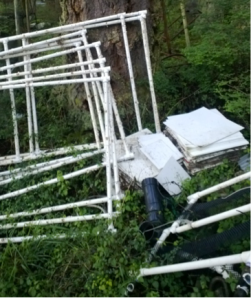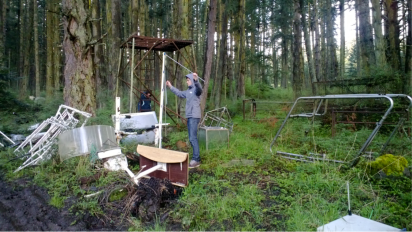It’s T10, and you know what that means? We are half way through the originally planned experiment length! As a small celebration, Natsuko, Collin (a ZooBot student), and I took a trip to the bone yard. This is not your traditional bone yard – though we did find a young deer skull – but rather a collection of parts. This bone yard is where experiment go to die. The idea is that scientists can store items here that still have some like left in them, but it no longer required for their experiment. Unfortunately, this method of recycling ended up being much better in theory than practice.
The bone yard is accessed by a muddy trail which has quite a bit of foliage growing on it. The entrance is framed by rusted pipes and metal sheeting. The bone yard itself is quite a bit large than I thought; the three of us spent over an hour explore. Strew across the ground are old nets with bouys, PVC piping and parts, and various other discarded items. There was even a trailer, left so long ago that it is now over grown with underbrush. The whole time I was walking through I thought: this is great because the next time my experiment requires eight broken boat motors and a bunch of rusted pipes I’m in business! Add some broken, mud caked plexi-glass and I could really get the ball rolling on my experiment.
Reduce. Reuse. Recycle. As a scientist in an environmentally consciences field I have heard these word repeatedly. But how is one supposed to reuse a net so water logged and rotten that it falls apart when you pull of it? How have we reduced the amount of chain we must use if we continue to pile it in a place where it is exposed to the elements and allowed to rust? How is littering natural preserve with plastic containers recycling?
A week and a half ago I spent thirty minutes cleaning plastics out of a large patch of flotsam trapped near our mesocosms by a detached stipe of bull kelp, and receive praise on my good stewardship. There were many comments of disgust over the few piece of trash I found floating in our beautiful waters. As scientists with a marine focus, I understand we have a soft spot for the oceans, but what about our terrestrial biosphere? How is it such a large amount of materials is being left in the middle of a gorgeous ecological preserve, and is not questioned by the members of our scientific community? As I walked through the area I couldn’t help but be slightly disappointed that so many materials which could have been reused- had they been stored correctly- have now become unnecessary and improperly disposed of waste.
I do not mean to besmirch the name of Friday Harbor Labs. On the contrary, I think the idea is excellent; it is just the execution that is flawed. There were in fact many weather proof items that can stand the test of time. For example, there was a broken estuarine circulation model and a rosette frame, both of which I was stoked to find. However, I question the logic of discarding a 1950s metal school desk with attached chair, as well as the four barbecue grills. My point is simply this: though the intent behind creating a recycling space may have been good, the result does not seem to be one I would expect this establishment to support. How could we, as a community of scientists, better this recycling process so we do not end up leaving behind our experimental remains for later generations to take care of?





